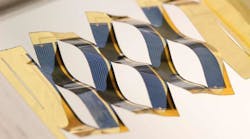Solar Tracking: Kirigami thin-film photovoltaic cells flex to track the sun
Motorized trackers that keep flat photovoltaic panels pointed toward the sun are, in their conventional form, heavy, bulky, and expensive-not suited for use on a typical home rooftop. But researchers at the University of Michigan (Ann Arbor, MI) have come up with a way to tilt solar cells in a simple, compact way such that the whole apparatus can fit within a flat solar panel.1 The only requirement is that the solar cells be of the thin-film variety and on a flexible substrate.
The technique is based on Japanese kirigami paper art, and is easily understandable upon seeing the apparatus (see figure). A cut pattern consisting of rows of alternating slits in an otherwise continuous sheet allows the array of solar cells, when pulled, to buckle in a predetermined way so that it expands and at the same time tilts at an angle that is virtually the same across the entire sheet. The tilt of the cells can be controlled to within ±1° of the predicted pointing vector. In a finished unit, the apparatus would be contained within a thin double-pane structure to protect it from the weather and keep it from sagging.
Prototype based on GaAs solar cells
The researchers' prototype was based on thin-film gallium arsenide (GaAs) solar cells, which were fabricated using nondestructive epitaxial lift-off. A gold film was deposited on the back of the GaAs cell structure, and another layer of gold was deposited on the top of the 3-μm-thick Kapton film substrate that the cells were to be mounted on. The cells were then brought into contact with the substrate; the two gold films cold-welded together, fixing the cells to the substrate. A bilayer coating of titanium dioxide (TiO2) and magnesium fluoride (MgF2) was deposited on the cells to reduce reflection at the oblique angles that occur from bowing of the kirigami structure when stretched.
In a test, the kirigami structure was stretched in a controlled way so that it tracked a moving Am1.5G (sunlight spectrum equivalent) collimated light source. The solar-cell current density was then measured as a function of illumination angle and the rate adjusted to test for variations in tracking performance.
In a simulation of a system placed in Phoenix, AZ at the summer solstice, the apparatus in various geometrical forms (varying the ratio of the slit-array orthogonal distances) was compared to a conventional single-axis solar-cell tracking system; the output energy density of the stretchable system was seen to approach that of the conventional system for geometries where the slits were long in relation to their parallel spacing. A more-practical geometry where the slits were shorter in relation to their parallel spacing also worked well, being only slightly less efficient.
According to the simulation, the kirigami-based device is almost as good as a conventional single-axis tracker, offering a 36% improvement over a stationary panel. Conventional trackers produce about 40% more energy than stationary panels under the same conditions, but they are bulky, prone to catching the wind and ten or more times heavier, says Max Shtein, an associate professor of materials science and engineering at the University of Michigan.
The structure was stretched and contracted through several hundred cycles with no change in output, although some crack propagation at the cuts was seen. The researchers are currently looking into optimizing the geometry and/or using other substrates with better stability (such a spring steel) to improve lifetime.
"The beauty of our design is, from the standpoint of the person who's putting this panel up, nothing would really change," says Shtein. "But inside, it would be doing something remarkable on a tiny scale: the solar cell would split into tiny segments that would follow the position of the sun in unison."
The University of Michigan has applied for a patent and is seeking partners to bring the technology to market.
REFERENCE
1. A. Lamoureux et al., NatureCommun. (2015); http://dx.doi.org/10.1038/ncomms9092.
About the Author
John Wallace
Senior Technical Editor (1998-2022)
John Wallace was with Laser Focus World for nearly 25 years, retiring in late June 2022. He obtained a bachelor's degree in mechanical engineering and physics at Rutgers University and a master's in optical engineering at the University of Rochester. Before becoming an editor, John worked as an engineer at RCA, Exxon, Eastman Kodak, and GCA Corporation.

